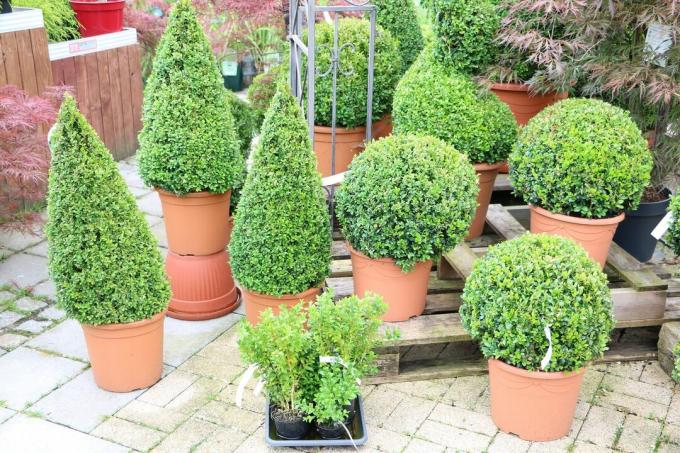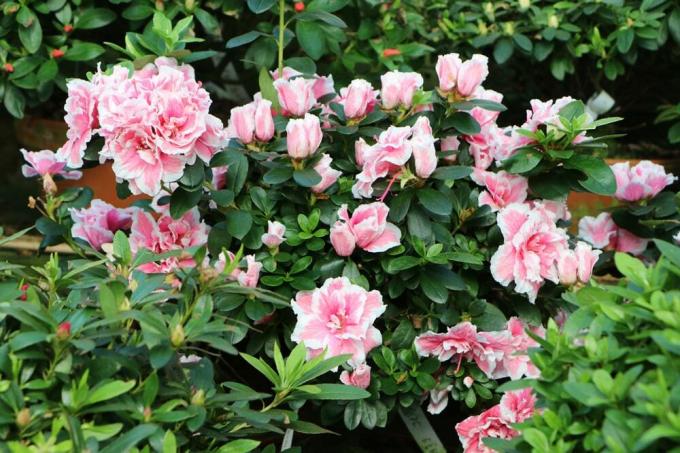

Table of contents
- Ornamental shrubs that cannot be cut into shape
- Possible topiary
- Right cutting time
- This is how to cut properly
- Tools and supplies required
- frequently asked Questions
- Worth knowing about topiary of ornamental trees in brief
- Conclusion: when should you cut ornamental trees?
A beautifully trimmed hedge or bushes and shrubs presented as a natural sculpture have long been at home in front yards as well as modern gardens. And also in public areas such as in castle gardens or in front of museums, trees are often provided with topiary. This topic has been dealt with since ancient times.
While some have these little mini masterpieces already cut to shape and ready to go at the hardware store or in buy from a tree nursery, others take the trouble to shape their trees accordingly bring. And this not only requires a little imagination, but also manual skills, the right tools and sufficient knowledge about trees and shrubs. Because ornamental trees cannot be trimmed arbitrarily.
Ornamental shrubs that cannot be cut into shape
Not all trees and shrubs are also ornamental trees and are suitable for a shape cut. When buying or selecting the right trees, make sure that you choose the following trees:
- yew
- boxwood
- Jaw
- cypresses
- hazelnut
- robinia
- and some maple species
There are of course other trees that would be suitable. In principle, every shrub, bush or hedge can be pruned individually. Some are just a little more “stubborn” than other strains. In the best case, choose trees that do not lose their leaves even in winter. So you always have beautiful ornamental trees in the garden to enjoy even in the cold season. In addition, as a beginner, you should always choose simple trees and shrubs. These would be, for example, cypresses or boxwood. Both types are easy to cut and shape, even for beginners. And if you prefer to have a hedge with a topiary, then this will also create a beautiful effect in your garden.
Possible topiary
You are completely free in your decision regarding the possible shapes that you can cut into your trees. The specialist distinguishes between basic forms, mixed forms, hedges and gates as well as tree walls. For starters, it pays to start with simple shapes like spheres or cylindrical shapes. After a little practice, the shapes can easily become fancier. How about, for example, donuts, a chair, a hat or even a watering can and a bucket? As I said, the possibilities are so diverse that even fairytale characters or something similar would be conceivable. In hedges, on the other hand, waves, edges or even corners can be cut. Just as you wish.
Tip:
When trimming hedges, make sure that a harmonious overall picture is created. Don't choose an overly "wild" form, but limit yourself to a light form that the viewer can also recognize in the end.
Right cutting time
Now the scissors cannot be applied to the wood all year round for a quick cut. Rather, you should choose late February or early March, or June and July. Make sure you don't catch a day that's too hot. Always cut only in the area where the wood is green. Otherwise you will get bald spots that don't look very attractive.
Tip:
Start slowly with the cutting and in between always orientate yourself on the result.
If this gradually conforms to the form you aspire to, then all is well. Otherwise, correct the cut and adjust accordingly.
This is how to cut properly
Trees usually grow upwards in the first step. You can also promote this by only cutting off the top shoot tips during a cut. But since you want to make a shape cut and you need abundance and a tree, which also grows laterally. You can always achieve this if you remove the central shoot and thus encourage the side buds to sprout. If you then remove these side shoots as well, you will get the bushy shape you need for a topiary.
The first step is to make a design cut. This first cut determines the rough shape of the wood. The next cuts are then called maintenance cuts. They ensure that the wood becomes bushier and denser, so that in the end a clearly visible shape without bare spots can develop. At the end comes the shape cut, which determines the final shape and is usually carried out in June.
Tools and supplies required
Here you have to decide between manual and electric tools. Please decide for yourself which tools you really need. A hedge trimmer that can be operated electrically for the first design cut is always very nice. The fine sanding at the end can also be done with manual scissors. With this you can cut more precisely. This is particularly important when a very unusual and complex shape is to be created. You will also need pruning shears, lawn edging shears, a guide line, a measuring rod and a plumb bob. If the wood is so big that you cannot see it, a ladder is essential. At very great heights even a work platform.
If you are unsure about creating the shape, use templates. This is particularly useful if you want to create a sphere.
Tip:
Since you only need the special tool every now and then, it is not absolutely necessary that you buy everything.
You can also borrow this in many hardware stores and garden centers. However, make a reservation in good time, as the time window for cutting is quite small and other garden enthusiasts could also come up with the idea of borrowing.
frequently asked Questions
It's always good to choose hardy shrubs that don't lose their leaves. Yew, cypress, boxwood, hornbeam and azaleas are therefore well suited. Of course, you can also use other trees.
The best time for pruning can be found at the end of February and in March. In addition, pruning can take place in June and July. You should choose June for the final shape cut.
Everything is possible. The question is whether you can cut everything yourself. For this reason, it is always better to start with simple shapes and then slowly "work your way up" to more difficult shapes.
Worth knowing about topiary of ornamental trees in brief
- First of all, you should know that some shrubs require regular pruning, such as roses that bloom more often or ornamental shrubs that bloom in late summer.
- Quite valuable trees such. B. the witch hazel, magnolia or laburnum should not be cut at all.
- The cut increases the abundance of flowers and fruits or a certain plant shape is achieved.
- When pruning, all shoots that have been damaged by diseases, injuries or frost are first cut off.
- Even rotten, mostly brownish shoots are cut back down to the healthy wood.
- Furthermore, all thin and weak shoots are cut down to the base.
- With a clearing cut, on the other hand, all shoots that are more than three to four years old are cut off directly above the ground.
- Once this work is done, you can start cutting the shape. Be careful not to create any holes!
- It is usually done with a pruning or already done with the clearing cut and the ornamental shrub was put "in its place".
- When cutting, it is still crucial that you use the right tool for it.
Conclusion: when should you cut ornamental trees?
In autumn you should only cut enough to prevent damage caused by wind damage or snow loads. A pruning takes place only in winter, but only in frost-free weather. This is usually the case in February. Trees that bloom in summer, such as summer lilac and trellis shrubs, should be radically cut down to approx. be cut back 20 cm. Shrubs that bloom in spring, however, are only cut back after flowering.
 garden editorial
garden editorial I write about everything that interests me in my garden.
Learn more about shrubs and woody plants

17 flowering hardy plants May to October
Many plants only show their full splendor for a short time. But there are also types and varieties with a particularly long flowering period from May to October, sometimes even longer. We present 17 flowering hardy plants.

25 hardy and evergreen ornamental trees
Ornamental trees are among the most popular plants in the garden. They have a decorative effect and set special accents in the green oasis. If you are tired of the gray of the cold season, you can plant trees that are hardy and evergreen.

Is barberry poisonous? | What is to be considered?
With their dense growth, numerous thorns and evergreen foliage, barberries are one of the most popular types of plants for a hedge in the garden. Before cultivating the sour thorn family (Berberidaceae), many ask themselves whether the plant is poisonous.

Azalea location: 6 important criteria
Azaleas are a flowering addition to the garden or living room, as long as they are in the right location. In the following guide to azaleas, we will tell you what to look out for.

How fast does a rhododendron grow? | Information about growth
How fast a rhododendron grows depends on various factors, including the variety, location and care. Growth can be accelerated under optimal conditions, while deficiencies lead to stunted growth.

Butterfly bush: the ideal location | Buddleia
The uncomplicated, easy-care and robust butterfly bush is suitable in the garden for borders, a flowering hedge or as a solitaire. Dwarf summer lilacs are ideal for pot culture. Buddleia bloom from June to October and are a magnet for many butterflies.


